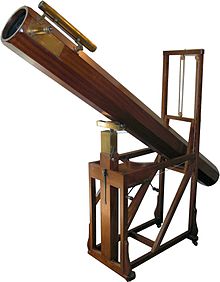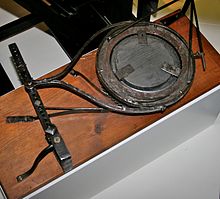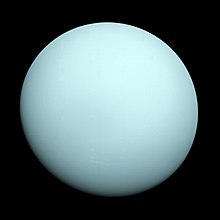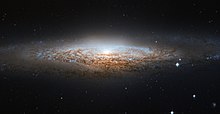Frederick William Herschel, KH, FRS (/ˈhɜːrʃəl, ˈhɛər-/;[2] German: Friedrich Wilhelm Herschel; 15 November 1738 – 25 August 1822) was a German-born British[3] astronomer, composer and brother of fellow astronomer Caroline Herschel, with whom he worked. Born in the Electorate of Hanover, Herschel followed his father into the Military Band of Hanover, before migrating to Great Britain in 1757 at the age of nineteen.
Herschel constructed his first large telescope in 1774, after which he spent nine years carrying out sky surveys to investigate double stars. Herschel published catalogs of nebulae in 1802 (2,500 objects) and in 1820 (5,000 objects). The resolving power of the Herschel telescopes revealed that many objects called nebulae in the Messier catalog were actually clusters of stars. On March 13, 1781, while making observations he made note of a new object in the constellation of Gemini. This would, after several weeks of verification and consultation with other astronomers, be confirmed to be a new planet, eventually given the name of Uranus. This was the first planet to be discovered since antiquity and Herschel became famous overnight. As a result of this discovery, George III appointed him Court Astronomer. He was elected as a Fellow of the Royal Society and grants were provided for the construction of new telescopes.
Herschel pioneered the use of astronomical spectrophotometry, using prisms and temperature measuring equipment to measure the wavelength distribution of stellar spectra. In addition, Herschel discovered infrared radiation. Other work included an improved determination of the rotation period of Mars, the discovery that the Martian polar caps vary seasonally, the discovery of Titania and Oberon(moons of Uranus) and Enceladus and Mimas (moons of Saturn). Herschel was made a Knight of the Royal Guelphic Order in 1816. He was the first President of the Royal Astronomical Society when it was founded in 1820. He died in August 1822, and his work was continued by his only son, John Herschel.
Early life and musical activities[]
Herschel was born in the Electorate of Hanover in Germany, then part of the Holy Roman Empire, one of ten children of Isaac Herschel by his marriage to Anna Ilse Moritzen, of German Lutheran ancestry. It has been proposed by Hershel's biographer Holden that his father's family traced its roots back to Jews from Moravia who converted to Christianity in the seventeenth century,[6][7] and they themselves were Lutheran Christians.[8]
Herschel's father was an oboist in the Hanover Military Band. In 1755 the Hanoverian Guards regiment, in whose band Wilhelm and his brother Jakob were engaged as oboists, was ordered to England. At the time the crowns of Great Britain and Hanover were united under King George II. As the threat of war with France loomed, the Hanoverian Guards were recalled from England to defend Hanover. After they were defeated at the Battle of Hastenbeck, Herschel's father Isaak sent his two sons to seek refuge in England in late 1757. Although his older brother Jakob had received his dismissal from the Hanoverian Guards, Wilhelm was accused of desertion[9] (for which he was pardoned by George III in 1782).[10]
Wilhelm, nineteen years old at this time, was a quick student of the English language. In England he went by the English rendition of his name, Frederick William Herschel. In addition to the oboe, he played the violin and harpsichord and later the organ.[11] He composed numerous musical works, including 24 symphonies and many concertos, as well as some church music.[12] Six of his symphonies were recorded in April 2002 by the London Mozart Players, conducted by Matthias Bamert (Chandos 10048).

Herschel moved to Sunderland in 1761 when Charles Avison immediately engaged him as first violin and soloist for his Newcastle orchestra, where he played for one season. In "Sunderland in the County of Durh: apprill [sic] 20th 1761" he wrote his Symphony No. 8 in C Minor. He was head of the Durham Militia band from 1760 to 1761.[14] He visited the home of Sir Ralph Milbanke at Halnaby Hall near Darlington in 1760,[8]:14 where he wrote two symphonies, as well as giving performances himself. After Newcastle, he moved to Leeds and Halifax where he was the first organist at St John the Baptist church (now Halifax Minster).[7]:411
In 1766, Herschel became organist of the Octagon Chapel, Bath, a fashionable chapel in a well-known spa, in which city he was also Director of Public Concerts.[15] He was appointed as the organist in 1766 and gave his introductory concert on 1 January 1767. As the organ was still incomplete, he showed off his versatility by performing his own compositions including a violin concerto, an oboe concerto and a harpsichord sonata.[16] On 4 October 1767, he performed on the organ for the official opening of the Octagon Chapel.[17]
His sister Caroline arrived in England on 24 August 1772 to live with William in New King Street, Bath.[1]:1–25 The house they shared is now the location of the Herschel Museum of Astronomy.[18] Herschel's brothers Dietrich, Alexander and Jakob (1734–1792) also appeared as musicians of Bath.[19] In 1780, Herschel was appointed director of the Bath orchestra, with his sister often appearing as soprano soloist.
Astronomy[]

Herschel's reading in natural philosophy during the 1770s indicates his personal interests but also suggests an intention to be upwardly mobile socially and professionally. He was well-positioned to engage with eighteenth-century "philosophical Gentleman" or philomaths, of wide-ranging logical and practical tastes.[21] Herschel's intellectual curiosity and interest in music eventually led him to astronomy. After reading Robert Smith's Harmonics, or the Philosophy of Musical Sounds (1749), he took up Smith's A Compleat System of Opticks (1738), which described techniques of telescope construction.[22] He also read James Ferguson's Astronomy explained upon Sir Isaac Newton's principles and made easy to those who have not studied mathematics (1756) and William Emerson's The elements of trigonometry (1749), The elements of optics (1768) and The principles of mechanics (1754).[21]
Herschel took lessons from a local mirror-builder and having obtained both tools and a level of expertise, started building his own reflecting telescopes. He would spend up to 16 hours a day grinding and polishing the speculum metal primary mirrors. He relied on the assistance of other family members, particularly his sister Caroline and his brother Alexander, a skilled mechanical craftsperson.[21]
He "began to look at the planets and the stars"[23] in May 1773 and on March 1, 1774, began an astronomical journal by noting his observations of Saturn's rings and the Great Orion Nebula (M42).[21] The English Astronomer Royal Nevil Maskelyne visited the Herschels while they were at Walcot (which they left on September 29, 1777).[24] By 1779, Herschel had also made the acquaintance of Sir William Watson, who invited him to join the Bath Philosophical Society.[21] Herschel became an active member, and through Watson would greatly enlarge his circle of contacts.

Double stars[]
Herschel's early observational work soon focused on the search for pairs of stars that were very close together visually. Astronomers of the era expected that changes over time in the apparent separation and relative location of these stars would provide evidence for both the proper motion of stars and, by means of parallax shifts in their separation, for the distance of stars from the Earth. The latter was a method first suggested by Galileo Galilei.[26] From the back garden of his house in New King Street, Bath, and using a 6.2-inch aperture (160 mm), 7-foot-focal-length (2.1 m) (f/13) Newtonian telescope "with a most capital speculum" of his own manufacture,[27] in October 1779, Herschel began a systematic search for such stars among "every star in the Heavens",[26]:5 with new discoveries listed through 1792. He soon discovered many more binary and multiple stars than expected, and compiled them with careful measurements of their relative positions in two catalogues presented to the Royal Society in London in 1782 (269 double or multiple systems)[28] and 1784 (434 systems).[29] A third catalogue of discoveries made after 1783 was published in 1821 (145 systems).[30][31]
The Rev. John Michell of Thornhill published work in 1767 on the distribution of double stars,[32] and in 1783 on "dark stars" (black holes), that may have influenced Herschel.[33] After Michell's death in 1793, Herschel bought a ten-foot-long, 30-inch reflecting telescope from Michell's estate.[34]
In 1797, Herschel measured many of the systems again, and discovered changes in their relative positions that could not be attributed to the parallax caused by the Earth's orbit. He waited until 1802 (in Catalogue of 500 new Nebulae, nebulous Stars, planetary Nebulae, and Clusters of Stars; with Remarks on the Construction of the Heavens) to announce the hypothesis that the two stars might be "binary sidereal systems" orbiting under mutual gravitational attraction, a hypothesis he confirmed in 1803 in his Account of the Changes that have happened, during the last Twenty-five Years, in the relative Situation of Double-stars; with an Investigation of the Cause to which they are owing.[26]:8–9 In all, Herschel discovered over 800 confirmed[35] double or multiple star systems, almost all of them physical rather than optical pairs. His theoretical and observational work provided the foundation for modern binary star astronomy;[17]:74 new catalogues adding to his work were not published until after 1820 by Friedrich Wilhelm Struve, James South and John Herschel.
Uranus[]

In March 1781, during his search for double stars, Herschel noticed an object appearing as a disk. Herschel originally thought it was a comet or a stellar disc, which he believed he might actually resolve.[38] He reported the sighting to Nevil Maskelyne the Astronomer Royal.[39] He made many more observations of it, and afterwards Russian Academician Anders Lexell computed the orbit and found it to be probably planetary.[40][41]
Herschel agreed, determining that it must be a planet beyond the orbit of Saturn.[42] He called the new planet the "Georgian star" (Georgium sidus) after King George III, which also brought him favour; the name did not stick.[43] In France, where reference to the British king was to be avoided if possible, the planet was known as "Herschel" until the name "Uranus" was universally adopted. The same year, Herschel was awarded the Copley Medal and elected a Fellow of the Royal Society.[41] In 1782, he was appointed "The King's Astronomer" (not to be confused with the Astronomer Royal).[44]
On August 1, 1782, Herschel and his sister Caroline moved to Datchet (then in Buckinghamshire but now in Berkshire). There he continued his work as an astronomer and telescope maker.[45] He achieved an international reputation for their manufacture, profitably selling over 60 completed reflectors to British and Continental astronomers.
Deep sky surveys[]

From 1782 to 1802, and most intensively from 1783 to 1790, Herschel conducted systematic surveys in search of "deep-sky" or non-stellar objects with two 20-foot-focal-length (610 cm), 12-inch-aperture (30 cm) and 18.7-inch-aperture (47 cm) telescopes (in combination with his favoured 6-inch-aperture instrument). Excluding duplicated and "lost" entries, Herschel ultimately discovered over 2,400 objects defined by him as nebulae.[7] (At that time, nebula was the generic term for any visually diffuse astronomical object, including galaxies beyond the Milky Way, until galaxies were confirmed as extragalactic systems by Edwin Hubble in 1924.[47])
Herschel published his discoveries as three catalogs: Catalogue of One Thousand New Nebulae and Clusters of Stars (1786), Catalogue of a Second Thousand New Nebulae and Clusters of Stars (1789) and the previously cited Catalogue of 500 New Nebulae ... (1802). He arranged his discoveries under eight "classes": (I) bright nebulae, (II) faint nebulae, (III) very faint nebulae, (IV) planetary nebulae, (V) very large nebulae, (VI) very compressed and rich clusters of stars, (VII) compressed clusters of small and large [faint and bright] stars, and (VIII) coarsely scattered clusters of stars. Herschel's discoveries were supplemented by those of Caroline Herschel (11 objects) and his son John Herschel (1754 objects) and published by him as General Catalogue of Nebulae and Clusters in 1864. This catalogue was later edited by John Dreyer, supplemented with discoveries by many other 19th-century astronomers, and published in 1888 as the New General Catalogue (abbreviated NGC) of 7,840 deep-sky objects. The NGC numbering is still the most commonly used identifying label for these celestial landmarks.
Works with his sister Caroline[]

Following the death of their father, William suggested that Caroline join him in Bath, England. In 1772, Caroline was first introduced to astronomy by her brother.[43][48][49]
Caroline spent many hours polishing the mirrors of high performance telescopes so that the amount of light captured was maximized. She also copied astronomical catalogs and other publications for William. After William accepted the office of King's Astronomer to George III, Caroline became his constant assistant.[50]
In October 1783, a new 20-foot telescope came into service for William. During this time, William was attempting to observe and then record all of the observations. He had to run inside and let his eyes readjust to the artificial light before he could record anything, and then he would have to wait until his eyes were adjusted to the dark before he could observe again. Caroline became his recorder by sitting at a desk near an open window. William would shout out his observations and she would write them down along with any information he needed from a reference book.[51]
Caroline began to make astronomical discoveries in her own right, particularly comets. In 1783, William built her a small Newtonian reflector telescope, with a handle to make a vertical sweep of the sky. Between 1783 and 1787, she made an independent discovery of M110 (NGC 205), which is the second companion of the Andromeda Galaxy. During the years 1786–1797, she discovered or observed eight comets.[52] She found fourteen new nebulae[53] and, at her brother's suggestion, updated and corrected Flamsteed's work detailing the position of stars.[54][55] She also rediscovered Comet Encke in 1795.[52]
Caroline Herschel's eight comets were published between 28 August 1782 to 5 February 1787. Five of her comets were published in Philosophical Transactions of the Royal Society. William was even summoned to Windsor Castle to demonstrate Caroline's comet to the royal family. William recorded this phenomenon himself, terming it "My Sister's Comet." She wrote letters to the Astronomer Royal to announce the discovery of her second comet, and wrote to Joseph Banks upon the discovery of her third and fourth comets.[49]
The Catalogue of stars taken from Mr Flamsteed's observations contained an index of more than 560 stars that had not been previously included.[53][55] Caroline Herschel was honoured by the Royal Astronomical Society for this work in 1828.[56]
Caroline also continued to serve as William Herschel's assistant, often taking notes while he observed at the telescope.[57] For her work as William's assistant, she was granted an annual salary of £50 by George III. Her appointment made her the first female in England to be honored with a government position.[58] It also made her the first woman to be given a salary as an astronomer.[59]
In June 1785, owing to damp conditions, William and Caroline moved to Clay Hall in Old Windsor. On 3 April 1786, the Herschels moved to a new residence on Windsor Road in Slough.[45] Herschel lived the rest of his life in this residence, which came to be known as Observatory House.[60] It was demolished in 1963.[61]
On 8 May 1788, William Herschel married the widow Mary Pitt (née Baldwin) at St Laurence's Church, Upton in Slough.[62] The marriage caused a lot of tension in the brother-sister relationship. Caroline has been referred to as a bitter, jealous woman who worshiped her brother and resented her sister-in-law for invading her domestic life. With the arrival of Mary, Caroline lost her managerial and social responsibilities in the household, and with them much of her status. Caroline destroyed her journals between the years 1788 to 1798, so her feelings during this period are not entirely known. According to her memoir, Caroline then moved to separate lodgings, but continued to work as her brother's assistant. When her brother and his family were away from their home, she would often return to take care of it for them. In later life, Caroline and Lady Herschel exchanged affectionate letters.[49]
Caroline continued her astronomical work after William's death in 1822. She worked to verify and confirm his findings as well as putting together catalogs of nebulae. Towards the end of her life, she arranged two-and-a-half thousand nebulae and star clusters into zones of similar polar distances. She did this so that her nephew, John, could re-examine them systematically. Eventually, this list was enlarged and renamed the New General Catalogue.[63] In 1828, she was awarded the Gold Medal of the Royal Astronomical Society for her work.[64]
Herschel's telescopes[edit][]
The most common type of telescope at that time was the refracting telescope, which involved the refraction of light through a tube using a convex glass lens. This design was subject to chromatic aberration, a distortion of an image due to the failure of light of different component wavelengths to converge. Optician John Dollond (1706–1761) tried to correct for this distortion by combining two separate lenses, but it was still difficult to achieve good resolution for far distant light sources.[43]
Reflector telescopes, invented by Isaac Newton in 1668, used a single concave mirror rather than a convex lens. The concave mirror gathered more light than a lens, reflecting it onto a flat mirror at the end of the telescope for viewing. A smaller mirror could provide greater magnification and a larger field of view than a convex lens. Newton's first mirror was 1.3 inches in diameter; such mirrors were rarely more than 3 inches in diameter.[43]
Because of the poor reflectivity of mirrors made of speculum metal, Herschel eliminated the small diagonal mirror of a standard Newtonian reflector from his design and tilted his primary mirror so he could view the formed image directly. This "front view" design has come to be called the Herschelian telescope.[65][66]:7
The creation of larger, symmetrical mirrors was extremely difficult. Any flaw would result in a blurred image. Because no one else was making mirrors of the size and magnification desired by Herschel, he determined to make his own.[43] This was no small undertaking. He was assisted by his sister Caroline and other family members. Caroline Herschel described the pouring of a 30-foot-focal-length mirror:
Herschel is reported to have cast, ground, and polished more than four hundred mirrors for telescopes, varying in size from 6 to 48 inches in diameter.[65][67] Herschel and his assistants built and sold at least sixty complete telescopes of various sizes.[65] Commissions for the making and selling of mirrors and telescopes provided Herschel with an additional source of income. The King of Spain reportedly paid £3,150 for a telescope.[49]
An essential part of constructing and maintaining telescopes was the grinding and polishing of their mirrors. This had to be done repeatedly, whenever the mirrors deformed or tarnished during use.[43] The only way to test the accuracy of a mirror was to use it.[65]
Named after Herschel[]
William Herschel, portrait by James Sharples, c. 1805
- The astrological symbol for planet Uranus () features the capital initial letter of Herschel's surname.
- Mu Cephei is also known as Herschel's Garnet Star
- Herschel, a crater on the Moon
- Herschel, a large impact basin on Mars
- The enormous crater Herschel on Saturn's moon Mimas
- The Herschel gap in Saturn's rings.
- 2000 Herschel, an asteroid
- The William Herschel Telescope on La Palma
- The Herschel Space Observatory, successfully launched by the European Space Agency on 14 May 2009. It is the largest space telescope of its kind
- Herschel Grammar School, Slough
- Rue Herschel, a street in the 6th Arrondissement of Paris.
- The Herschel Building at Bath College, Bath
- The Herschel building at Newcastle University, Newcastle, United Kingdom
- Herschel Museum of Astronomy, at 19 New King Street in Bath.
- Herschelschule, Hanover, Germany, a grammar school
- The Herschel Observatory, at the Universitas School in Santos, Brazil.
- The lunar crater C. Herschel, the asteroid 281 Lucretia, and the comet 35P/Herschel-Rigollet are named after his sister Caroline Herschel.
- The public house "Herschel Arms" at 22 Park Street, Slough is named after him and is quite close to the site of Observatory House.
- Herschel Astronomical Society, the operator of the Herschel Memorial Observatory based in Eton, Berkshire.
- Herschel Park, Slough.
- The shape of Slough Bus Station, built in 2011, was inspired by Herschel's infrared experiment.